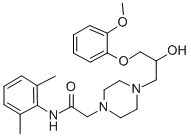Description
Ranolazine (142387-99-3) is an FDA-approved drug used for the treatment of chronic angina. It inhibits the late inward sodium current in heart muscle leading to decreased intracellular calcium levels.1?Ranolazine blocks Nav 1.4, 1.5, 1.7 and 1.8 (IC50‘s = 2.42, 6.22, 1.72(10.33), 21.53 μM respectively.
Uses
Ranolazine is for the treatment of chronic angina. It should be used in combination with amlodipine, beta-blockers or nitrates.
Definition
ChEBI: N-(2,6-dimethylphenyl)-2-{4-[2-hydroxy-3-(2-methoxyphenoxy)propyl]piperazin-1-yl}acetamide is an aromatic amide obtained by formal condensation of the carboxy group of 2-{4-[2-hydroxy-3-(2-methoxyphenoxy)propyl]piperazin-1-yl}acetic acid with the amino group of 2,6-dimethylaniline. It is a monocarboxylic acid amide, an aromatic amide, a N-alkylpiperazine, a secondary alcohol and a monomethoxybenzene.
References
1) Belardinelli?et al., (2006),?Inhibition of the late sodium current as a potential cardioprotective principle: effects of the late sodium current inhibitor ranolazine; Heart,?92?iv6
2) Wang?et al. (2008),?State- and Use-Dependent Block of Muscle Nav1.4 and Neuronal Nav1.7 Voltage-Gated Na+-Channel Isoforms by Ranolazine; Mol. Pharmacol.?73?940
3) Rajamani?et al., (2008),?Block of tetrodotoxin-sensitive, Na(V)1.7 and tetrodotoxin-resistant, Na(V)1.8, Na+ channels by ranolazine; Channels(Austin)?2?449
